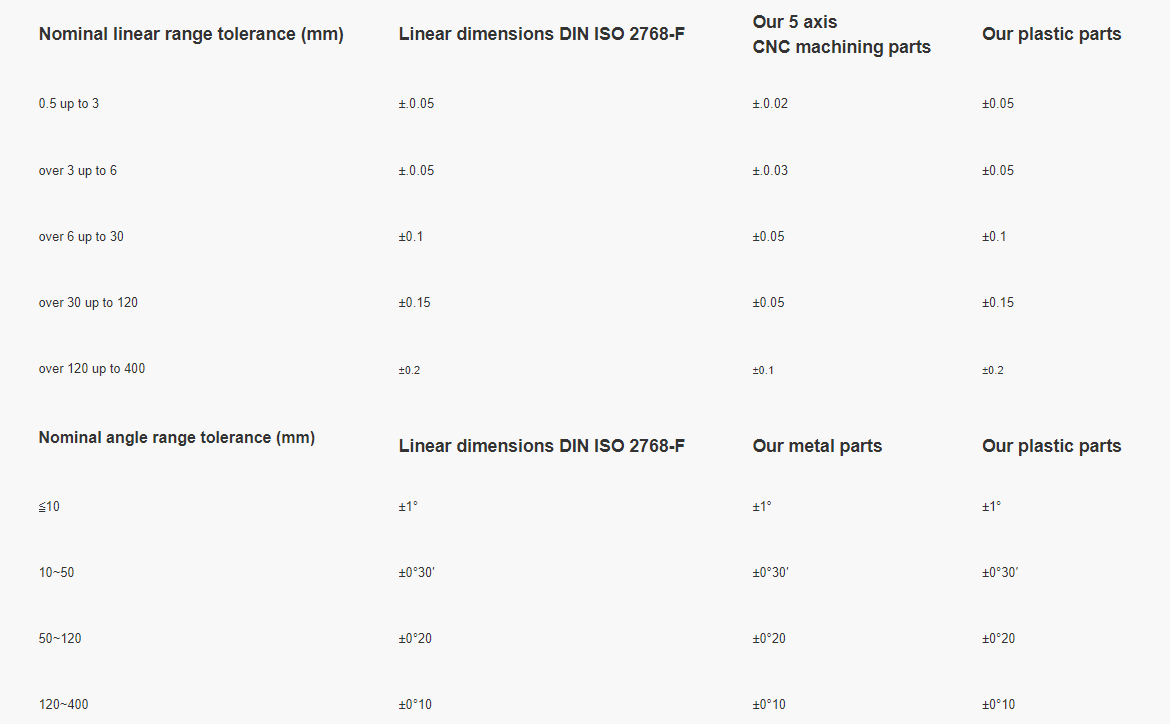15 years one-stop China custom CNC machining parts factory

Hey there I’m VMT Sam!
With 25 years of CNC machining experience we are committed to helping clients overcome 10000 complex part-processing challenges all to contribute to a better life through intelligent manufacturing. Contact us now
 135 |
Published by VMT at Apr 27 2024
135 |
Published by VMT at Apr 27 2024
In the field of CNC machining part manufacturing, precision CNC machined parts have garnered attention for their high precision, quality, and efficiency. Tolerance, as a crucial indicator of machining accuracy, is particularly important for precision CNC machined parts. So, what is the minimum tolerance achievable for precision CNC machined parts? This article will delve into this topic, providing readers with in-depth professional knowledge.
I. Basic Concept of Tolerance for Precision CNC Machined Parts
Tolerance refers to the difference between the actual dimensions, shapes, and positions of parts during the manufacturing process and their ideal states, influenced by various factors. In precision CNC machining, controlling tolerance is one of the key factors to ensure part quality and performance. The size of tolerance directly determines the accuracy level and applicable scope of parts.

II. Factors Influencing Tolerance for Precision CNC Machined Parts
The tolerance of precision CNC machined parts is influenced by various factors, mainly including:
Machine Tool Accuracy: The accuracy of CNC machine tools directly determines the precision of machined parts. High-precision CNC machine tools can provide a more stable and precise machining environment, thus reducing part tolerance.
Tool Quality: Factors such as the sharpness, wear resistance, and stability of tools will affect the tolerance of machined parts. High-quality tools can reduce cutting forces and thermal deformation, thereby improving part accuracy.
Programming Techniques: The accuracy and rationality of CNC programming directly affect the precision of machined parts. Reasonable programming can reduce errors and deviations during machining, achieving higher accuracy requirements.
Material Properties: Different materials have different properties such as hardness, toughness, and thermal expansion coefficient, which also affect the tolerance of machined parts. Choosing suitable materials and processes is crucial for reducing tolerance.

III. The Minimum Limit of Tolerance for Precision CNC Machined Parts
The minimum limit of tolerance for precision CNC machined parts depends on the comprehensive effects of various factors. In actual machining processes, due to limitations in machine tools, tools, programming, and materials, tolerances are often difficult to reach the theoretical minimum value. However, with the continuous advancement of technology and equipment updates, the tolerance of precision CNC machined parts is constantly decreasing.
Currently, some advanced CNC machining factories can achieve extremely high machining accuracy, allowing the tolerance of precision CNC machined parts to reach very low levels. For example, in some fields with high precision requirements such as aerospace and medical equipment, the tolerance of precision CNC machined parts can be controlled within the micron level or even smaller.
It is worth noting that the size of tolerance is not the lower, the better. In practical applications, it is necessary to select a suitable tolerance range according to the specific requirements and operating environments of parts. Too low tolerance may increase machining costs, reduce production efficiency, and even affect the performance and reliability of parts.
IV. Measures to Improve Tolerance for Precision CNC Machined Parts
To reduce the tolerance of precision CNC machined parts and improve machining accuracy, measures can be taken from the following aspects:
Selecting high-precision CNC machine tools and high-quality tools to ensure the stability and reliability of machining equipment.
Optimizing CNC programming techniques to reduce programming errors and deviations, improving the accuracy and efficiency of the machining process.
Strictly controlling material selection and preprocessing processes to ensure the stability and reliability of material properties.
Strengthening monitoring and adjustment during the machining process to promptly detect and correct machining errors, ensuring that part accuracy meets requirements.
V. Future Development Trends
With the continuous advancement and innovation of manufacturing technology, the tolerance accuracy of precision CNC machined parts will continue to improve. In the future, with the application and popularization of high-precision CNC machine tools, intelligent tools, advanced programming techniques, etc., the tolerance range of precision CNC machined parts will further shrink, meeting the manufacturing requirements of higher precision.
Meanwhile, with the development of digitalization and intelligence in manufacturing technology, the machining process of precision CNC machined parts will become more automated and intelligent, improving machining efficiency and quality stability. This will help further reduce part tolerance and improve overall manufacturing levels.
In conclusion, the minimum limit of tolerance for precision CNC machined parts is a dynamic development process, influenced and restricted by various factors. By continuously optimizing machining equipment, processes, and technological means, we can gradually reduce part tolerance, improving manufacturing accuracy and quality levels. In future development, precision CNC machined parts will continue to play an important role in promoting the progress and development of the manufacturing industry.
Ready To Start Your Next Project?
Get Instant Quote

Request a Free Quote
Send us a message if you have any questions or request a quote. We will get back to you ASAP!